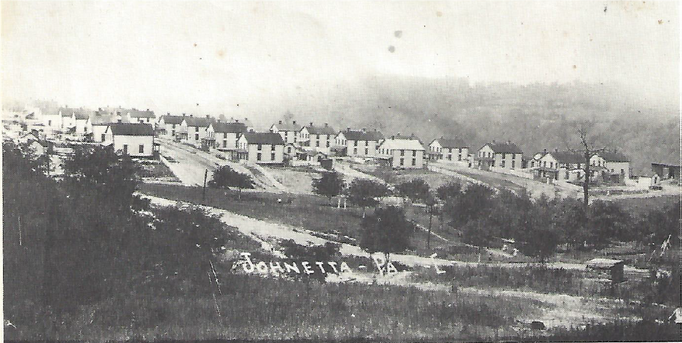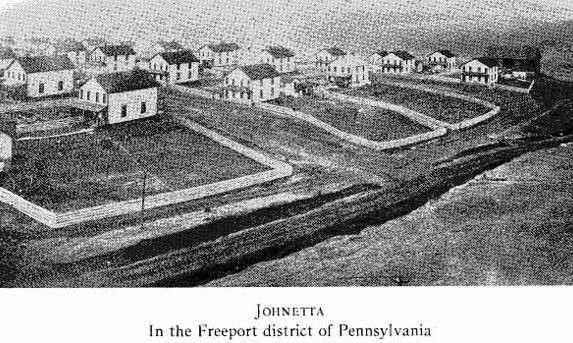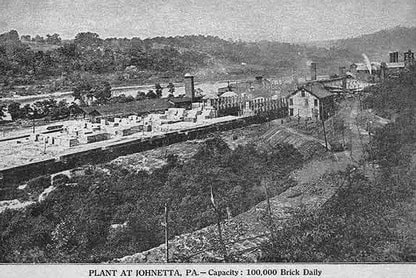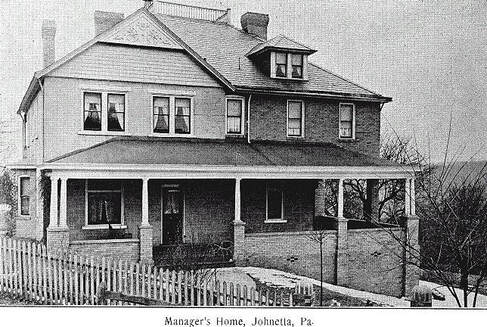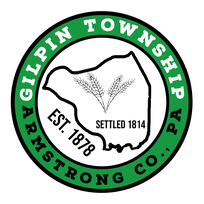A Brief History of Gilpin Township
Settled between 1812 and 1814, Gilpin Township was originally merged with the neighboring townships of Bethel and Parks, known as Allegheny Township (Chartered March 12, 1800). Finding it was too large to manage and supervise, the three split with the help of its namesake John Gilpin, Esq. and Gilpin Township was incorporated on December 26, 1878. Gilpin Township is home to many small villages and communities such as Schenley, Aladdin, Forks Church, Johnetta, Godfrey Landing, Georgetown, Baghdad, and Banfield, each of which have a large history of their own.
The earliest industries of the township were the sawmills of Michael Barrickman and Philip Klingensmith, the former on Elder's run and the latter on the same run, but higher up. The first was built in 1812 and the last in 1817. In 1914, Gilpin Township was, so far as manufacturing was concerned, possibly ahead of any other in the country, it being right at the junction of the Kiskiminetas and Allegheny rivers, so giving drainage to manufacturing sites which can scarcely be excelled by any township in the several counties adjoining.
The earliest industries of the township were the sawmills of Michael Barrickman and Philip Klingensmith, the former on Elder's run and the latter on the same run, but higher up. The first was built in 1812 and the last in 1817. In 1914, Gilpin Township was, so far as manufacturing was concerned, possibly ahead of any other in the country, it being right at the junction of the Kiskiminetas and Allegheny rivers, so giving drainage to manufacturing sites which can scarcely be excelled by any township in the several counties adjoining.
Johnetta
The town of Johnetta, chartered January 26, 1895 and dissolved June 4, 1930, was located at one of the most beautiful points in the Allegheny valley, the houses being built on a high bluff overlooking the river. Each house was surrounded by a large plot of ground suitable for gardening, and fruit and shade trees were planted along the streets. The town depended entirely upon the operations of the Pittsburgh-Buffalo Company, controlled by the Jones interests. John H. Jones, president of the company, residing there all the year round. The town was thoroughly sewered and supplied with good water, so that a more picturesque and healthful manufacturing location could not be imagined. The amusement hall was an interesting feature of the town. It contained standard bowling alleys, billiard and pool tables, a refreshment stand, and a large roller skating rink, which was also used for a meeting place and for popular entertainments. The town consisted of 140 frame houses, sixteen brick residences, a store, schoolhouse, and the Johnetta Memorial Church, presided over by Rev. Walter Kennedy. The houses were heated by gas taken from the company's own wells. The population was 662, of which about 500 are employees of the company. The Johnetta Plant of the United States Sewer Pipe Company utilized the famous Kittanning clay for the manufacture of refractory products. This clay immediately underlied the Kittanning coal, which was mined in advance of the clay, and which found a ready market at the northern lake ports. The clay seam was about 15 feet in thickness, of exceptional purity, and adapted to the manufacture of pavers, high-grade face brick and sewer pipe.
The town of Johnetta, chartered January 26, 1895 and dissolved June 4, 1930, was located at one of the most beautiful points in the Allegheny valley, the houses being built on a high bluff overlooking the river. Each house was surrounded by a large plot of ground suitable for gardening, and fruit and shade trees were planted along the streets. The town depended entirely upon the operations of the Pittsburgh-Buffalo Company, controlled by the Jones interests. John H. Jones, president of the company, residing there all the year round. The town was thoroughly sewered and supplied with good water, so that a more picturesque and healthful manufacturing location could not be imagined. The amusement hall was an interesting feature of the town. It contained standard bowling alleys, billiard and pool tables, a refreshment stand, and a large roller skating rink, which was also used for a meeting place and for popular entertainments. The town consisted of 140 frame houses, sixteen brick residences, a store, schoolhouse, and the Johnetta Memorial Church, presided over by Rev. Walter Kennedy. The houses were heated by gas taken from the company's own wells. The population was 662, of which about 500 are employees of the company. The Johnetta Plant of the United States Sewer Pipe Company utilized the famous Kittanning clay for the manufacture of refractory products. This clay immediately underlied the Kittanning coal, which was mined in advance of the clay, and which found a ready market at the northern lake ports. The clay seam was about 15 feet in thickness, of exceptional purity, and adapted to the manufacture of pavers, high-grade face brick and sewer pipe.
A glimpse into the past of Johnetta.
Bagdad
Four miles above Schenley, on the Kiskiminetas river, and two miles below Leechburg is the old village of Bagdad, famous in canal days and since. It was at this old town, or a short distance below it, that a point on the Pennsylvania canal known for years as "Wherry's Defeat" was located. The following incident or disaster gave rise to this name. When building this section of the canal the late James Wherry, of South Bend township, this county, had the contract, and it was found necessary to build an extensive riprap or retaining wall sloping from the edge of the towpath to the river. Just when it was nearing completion the Old "Kiski" got on one of her "tears" and swept away the work of months and with it several thousand dollars of the contractors' hard earned and not too plentiful money. The wall was rebuilt. Bagdad became prominent as a salt producing company, and some of the best wells along this river, famous then for this industry, were drilled at this place and above and below it, most of the salt boilers and miners lived in the little village. Among the old-time salt manufacturers were Daniel Hill, David Lynch, Daniel Kistler, Capt. Samuel Kistler and his brother John. There were also Clines, Stulls, Shusters, Sherbondies, Shirys, Klingensmiths, and Walters and a host of others, the long roll of which it is impossible now to record.
Four miles above Schenley, on the Kiskiminetas river, and two miles below Leechburg is the old village of Bagdad, famous in canal days and since. It was at this old town, or a short distance below it, that a point on the Pennsylvania canal known for years as "Wherry's Defeat" was located. The following incident or disaster gave rise to this name. When building this section of the canal the late James Wherry, of South Bend township, this county, had the contract, and it was found necessary to build an extensive riprap or retaining wall sloping from the edge of the towpath to the river. Just when it was nearing completion the Old "Kiski" got on one of her "tears" and swept away the work of months and with it several thousand dollars of the contractors' hard earned and not too plentiful money. The wall was rebuilt. Bagdad became prominent as a salt producing company, and some of the best wells along this river, famous then for this industry, were drilled at this place and above and below it, most of the salt boilers and miners lived in the little village. Among the old-time salt manufacturers were Daniel Hill, David Lynch, Daniel Kistler, Capt. Samuel Kistler and his brother John. There were also Clines, Stulls, Shusters, Sherbondies, Shirys, Klingensmiths, and Walters and a host of others, the long roll of which it is impossible now to record.
Schenley and Aladdin
In 1888 the Schenley Distilling Company was established at the junction of the Allegheny and the Kiskiminetas rivers, in Gilpin township and the village has been called after the company ever since. They had five warehouses, with a capacity of 10,000 barrels per year, and employed thirty men, who, with their families, composed the population of the village of Schenley — about 150 souls. The capitalization of the company was $400,000. The place also had two stores and a school. One of the large warehouses was burned in July, 1912, entailing a loss of $350,000, over one hundred barrels of whiskey being burned.
In 1894 a coal works was started at Aladdin to work the Freeport vein of coal, which could be mined by "drifting," as it was termed. A company composed of miners undertook to run this, but were unable to finance it, and in 1898 the works were purchased by Joseph G. Beale, of Leechburg, who was already in the coal business at that place. He operated the works, the opening being on the Buffalo & Allegheny division of the Pennsylvania Railroad, formerly known in Armstrong county history as the Allegheny Valley Railroad. This company was chartered as the Aladdin Coal Company. In 1890 a Greek named William Porterie came to Schenley, having in some way heard of the pitch or waste from the cannel coal oil and for several years made a considerable sum distilling and melting the residue, which he dug up on the grounds of the old North American Oil Works. In the meantime, he built quite a large candy factory at Aladdin station, and having acquired some lands from the Schenley estate, owned by Mary Schenley of England, who was still living at that time, he drilled for gas and was rewarded by striking a good flow. He put down other wells and for several years furnished the Enterprise Gas Company of Freeport, and also the Leechburg Gaslight and Fuel Company of Leechburg, with gas, so that this little point right at the junction of the Allegheny and Kiskiminetas had been one of the most important for its area of any place in the county.
In 1888 the Schenley Distilling Company was established at the junction of the Allegheny and the Kiskiminetas rivers, in Gilpin township and the village has been called after the company ever since. They had five warehouses, with a capacity of 10,000 barrels per year, and employed thirty men, who, with their families, composed the population of the village of Schenley — about 150 souls. The capitalization of the company was $400,000. The place also had two stores and a school. One of the large warehouses was burned in July, 1912, entailing a loss of $350,000, over one hundred barrels of whiskey being burned.
In 1894 a coal works was started at Aladdin to work the Freeport vein of coal, which could be mined by "drifting," as it was termed. A company composed of miners undertook to run this, but were unable to finance it, and in 1898 the works were purchased by Joseph G. Beale, of Leechburg, who was already in the coal business at that place. He operated the works, the opening being on the Buffalo & Allegheny division of the Pennsylvania Railroad, formerly known in Armstrong county history as the Allegheny Valley Railroad. This company was chartered as the Aladdin Coal Company. In 1890 a Greek named William Porterie came to Schenley, having in some way heard of the pitch or waste from the cannel coal oil and for several years made a considerable sum distilling and melting the residue, which he dug up on the grounds of the old North American Oil Works. In the meantime, he built quite a large candy factory at Aladdin station, and having acquired some lands from the Schenley estate, owned by Mary Schenley of England, who was still living at that time, he drilled for gas and was rewarded by striking a good flow. He put down other wells and for several years furnished the Enterprise Gas Company of Freeport, and also the Leechburg Gaslight and Fuel Company of Leechburg, with gas, so that this little point right at the junction of the Allegheny and Kiskiminetas had been one of the most important for its area of any place in the county.
All History is found from the Armstrong County Genealogy Project and can be accessed here.
Additional History from 2003 Comprehensive Plan
Indians occupied the section of Gilpin Township where the Kiski and Allegheny River valleys meet. The Indian Village, Atteques, was located at Schenley. Conrad Wiser was an early missionary to the Indians and visited the village in 1748. Early settlers included Philip Bolen, James Coulter, and the John, Philip, Peter and Nicholas Klingensmith families. Some of what is now Gilpin Township was part of “Old Westmoreland.” The land at the point of the two rivers was first surveyed by John Montgomery in 1766. General Brodhead sent scouts to spy on the Indians in the Schenley area in 1799. As late as 1838, there were traces of a round fort which was built on land now owned by the Schenley Industrial Park. This fort was three and one-half feet high and occupied three acres. In 1935, an Indian burial ground was discovered during construction of a sewer at Schenley. The site contained skeletons, tomahawks, and stone vessels.
In 1814, the Klingensmith Gristmill was built near Bagdad. Nearby, a sawmill was operated by Jacob Riggle. The Penn Oil Works was built near the Schenley Distillery in 1856 to distill coal oil. Because of petroleum drilling at the site, the business was closed. Other businesses which exploited the local resources included the Breton, Johnston and Company which began operations of an oil works at Aladdin in 1860. Later the same plant was operated by Dr. W. H. C. Tweddle which makes lubrication oil and paraffin. The process consumed 8,000 barrels of oil a month. The business was later purchased by Standard Oil.
Aladdin was incorporated as a borough in 1876. Another early industrial enterprise was the brick making plant at Johnetta which began production in about 1900. The plant produced an excellent grade of reddish brown brick. The plant was in operation for 20 years. During that period, some of the bricks used to construct the Alcoa plant at New Kensington were produced at the site. Brick homes for employees were erected. The business ceased operation in 1920.
One of the first Post Offices in Western Pennsylvania opened at the Point, called Kiskiminetas in 1824. John Royer was the first Postmaster. The first Schenley Post Office opened in 1862. The first school was constructed in 1812, on the then Peter Klingensmith farm. James Stitt was the teacher. The Shady Grove School was built before 1835 on the Schenley Road. Both schools were constructed from unhewn logs and had slab doors. The windows were made from paper dipped in bear’s grease. Other schools included the old Georgetown School erected in 1890. The Consolidated School was erected in 1939. Spruce College operated for a time in the area. The Rev. J. A. Campbell was the first county school superintendent.
The first service of the Forks Church was held in the home and barn of John Hill in 1812. The congregation formally organized in 1817. The first church was erected at the junction of the Allegheny and Kiskiminetas Rivers and was named for its location. The first church was in use for 50 years. A second church was built on the Leechburg-Kittanning Road in 1891. This church burned in 1905 and was replaced by the present building.
As the railroads became popular for travel and the transportation of goods and raw products, Kiski Junction became a thriving passenger terminal. The site included a modern station and housing for crews. The dam on the Allegheny River at Schenley was built in 1922. This dam was constructed to facilitate river traffic which was a major means of transportation. The dam made the shipment of coal, sand, gravel, and other products by barge possible.
The Mt. Joy Grange was chartered in 1875 with 35 original members. Daniel Gosser was the first master of the organization. Throughout its history, several times the organization was dormant but each time was reorganized.
The Gilpin Fire Department was founded in 1941 and a variety of fire equipment, vehicles, and pumpers were part of the inventory. In 1969, an emergency truck to handle auto accidents and river rescue was added.
The Gilpin Police Department was founded in 1971 with part-time policemen who used their own vehicles. Since that time, a multiple patrol cars have been purchased. The officers maintain law and order for the citizens of the township and coordinate with surrounding communities when needed.
The township is the site of the Leechburg Area Pool and Gilpin/Leechburg Area Park. The pool and park are adjacent to each other and offer recreational opportunities including picnicking, tennis, baseball and softball for the citizens of the Region. The pool and park are operated by two separate nonprofit entities.
Indians occupied the section of Gilpin Township where the Kiski and Allegheny River valleys meet. The Indian Village, Atteques, was located at Schenley. Conrad Wiser was an early missionary to the Indians and visited the village in 1748. Early settlers included Philip Bolen, James Coulter, and the John, Philip, Peter and Nicholas Klingensmith families. Some of what is now Gilpin Township was part of “Old Westmoreland.” The land at the point of the two rivers was first surveyed by John Montgomery in 1766. General Brodhead sent scouts to spy on the Indians in the Schenley area in 1799. As late as 1838, there were traces of a round fort which was built on land now owned by the Schenley Industrial Park. This fort was three and one-half feet high and occupied three acres. In 1935, an Indian burial ground was discovered during construction of a sewer at Schenley. The site contained skeletons, tomahawks, and stone vessels.
In 1814, the Klingensmith Gristmill was built near Bagdad. Nearby, a sawmill was operated by Jacob Riggle. The Penn Oil Works was built near the Schenley Distillery in 1856 to distill coal oil. Because of petroleum drilling at the site, the business was closed. Other businesses which exploited the local resources included the Breton, Johnston and Company which began operations of an oil works at Aladdin in 1860. Later the same plant was operated by Dr. W. H. C. Tweddle which makes lubrication oil and paraffin. The process consumed 8,000 barrels of oil a month. The business was later purchased by Standard Oil.
Aladdin was incorporated as a borough in 1876. Another early industrial enterprise was the brick making plant at Johnetta which began production in about 1900. The plant produced an excellent grade of reddish brown brick. The plant was in operation for 20 years. During that period, some of the bricks used to construct the Alcoa plant at New Kensington were produced at the site. Brick homes for employees were erected. The business ceased operation in 1920.
One of the first Post Offices in Western Pennsylvania opened at the Point, called Kiskiminetas in 1824. John Royer was the first Postmaster. The first Schenley Post Office opened in 1862. The first school was constructed in 1812, on the then Peter Klingensmith farm. James Stitt was the teacher. The Shady Grove School was built before 1835 on the Schenley Road. Both schools were constructed from unhewn logs and had slab doors. The windows were made from paper dipped in bear’s grease. Other schools included the old Georgetown School erected in 1890. The Consolidated School was erected in 1939. Spruce College operated for a time in the area. The Rev. J. A. Campbell was the first county school superintendent.
The first service of the Forks Church was held in the home and barn of John Hill in 1812. The congregation formally organized in 1817. The first church was erected at the junction of the Allegheny and Kiskiminetas Rivers and was named for its location. The first church was in use for 50 years. A second church was built on the Leechburg-Kittanning Road in 1891. This church burned in 1905 and was replaced by the present building.
As the railroads became popular for travel and the transportation of goods and raw products, Kiski Junction became a thriving passenger terminal. The site included a modern station and housing for crews. The dam on the Allegheny River at Schenley was built in 1922. This dam was constructed to facilitate river traffic which was a major means of transportation. The dam made the shipment of coal, sand, gravel, and other products by barge possible.
The Mt. Joy Grange was chartered in 1875 with 35 original members. Daniel Gosser was the first master of the organization. Throughout its history, several times the organization was dormant but each time was reorganized.
The Gilpin Fire Department was founded in 1941 and a variety of fire equipment, vehicles, and pumpers were part of the inventory. In 1969, an emergency truck to handle auto accidents and river rescue was added.
The Gilpin Police Department was founded in 1971 with part-time policemen who used their own vehicles. Since that time, a multiple patrol cars have been purchased. The officers maintain law and order for the citizens of the township and coordinate with surrounding communities when needed.
The township is the site of the Leechburg Area Pool and Gilpin/Leechburg Area Park. The pool and park are adjacent to each other and offer recreational opportunities including picnicking, tennis, baseball and softball for the citizens of the Region. The pool and park are operated by two separate nonprofit entities.
